
Soundskrit developed the first high-performance directional MEMS microphone on the market, leveraging years of research in bio-inspired MEMS based on how spiders and other insects in nature hear. In combination with Soundskrit’s in-house audio processing algorithms, directional microphones can be used to capture and isolate any sound in an environment with a fraction of the size, power, and computation of traditional omnidirectional-based microphone arrays. Soundskrit was founded in 2019 and is headquartered in Montreal, Quebec with an R&D facility in Ann Arbor, Michigan.
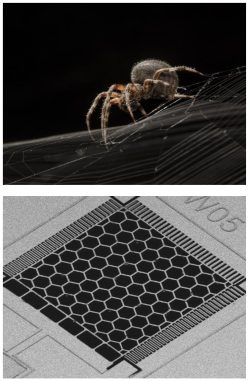
Soundskrit is Inspired by Nature
In nature, every mammal has evolved to use directional microphones for their unique needs. Unlike conventional microphones, which often attempt to mimic human hearing but don’t easily scale down in size, insects provide a fascinating example of efficient auditory systems. Despite their incredibly small auditory organs, insects demonstrate exceptional sound isolation by utilizing an acoustic phenomenon that only exists at the microscale. These remarkable creatures sense air flow through tiny hairs, enabling them to pinpoint sounds with remarkable precision. Soundskrit has taken inspiration from nature and unlocked the physics behind these incredible systems, successfully translating this knowledge to silicon-based technologies, promising innovative solutions for sound detection and directionality.
The World’s First Noise Adaptive Microphone
Reimagining audio capture involved a unique approach where hardware and software were codeveloped, resulting in an ambitious goal with remarkable outcomes. Utilizing a single chip, Soundskrit eliminated significantly more noise than traditional microphone arrays, enabling crystal clear audio capture from a wide range of devices. The technology creates incredibly immersive experiences with true stereo capture, bringing professional-grade audio to everyday devices. It can track both the direction and distance of any number of sound sources in any environment. Sound is harnessed to enhance the user experience, revolutionizing the way we interact with technology.
The SKR0400 Directional Microphone

Soundskrit developed the first high-performance MEMS directional microphone. The MEMS transducer was redesigned to move in sync with surrounding air motion. The SKR0400 offers dipole directionality in an ultra-compact form measuring 3.5×2.65×1.1mm³.
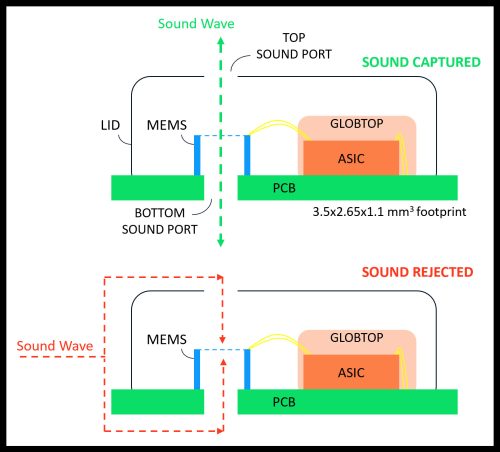
SKR0400 Directivity Index
When assessing a microphone’s performance, it’s essential to consider the directivity index (𝑫𝑰), which measures its directionality. The average 𝑫𝑰 is a weighted average of this measure across the audio spectrum. The SKR0400, with an average 𝑫𝑰 of 4.8dB, achieves the ideal average 𝑫𝑰 for a dipole microphone. What sets it apart is its consistent dipole performance across the entire audio spectrum, a challenging feat for traditional microphone arrays.
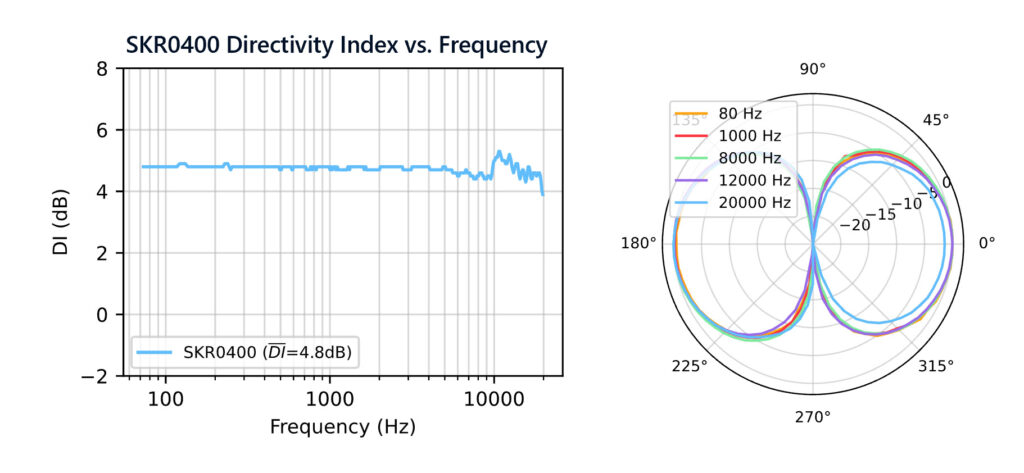
SNR Comparison
To achieve directionality similar to Soundskrit microphones, you typically need differential arrays. However, using omnidirectional microphones in such arrays leads to a significant drop in signal-to-noise ratio (SNR). For instance, when using a pair of 70dB SNR omnidirectional microphones spaced 10mm apart, the effective directional SNR drops to only 53dB, resulting in a 17dB SNR loss. In contrast, the SKR0400 dipole microphone offers a remarkable 10.5dB SNR improvement compared to alternative differential microphone arrays, effectively reducing system noise. The nearest competing microphone, which relies on a traditional MEMS, achieves only 51dB SNR. The SKR0400 outperforms the closest competing directional microphone, offering an impressive ~12dB SNR improvement. Soundskrit sets a new standard in SNR performance.
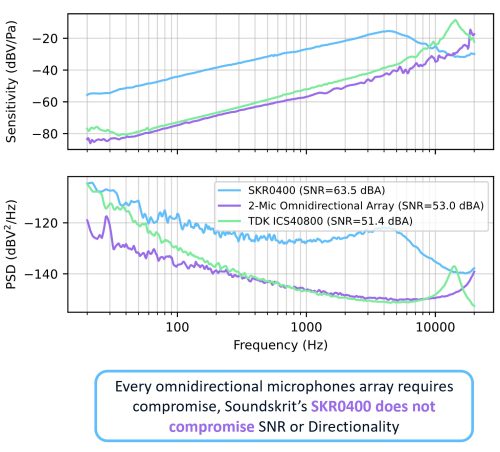
Directionality Comparison
Soundskrit – Directional Microphone
• 63.5dB SNR
• 4.8dB Average DI
• One microphone
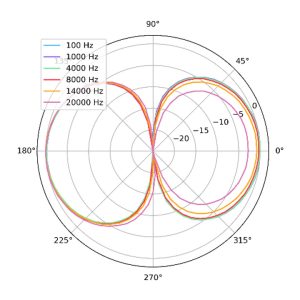
TDK ICS40800 – Directional Microphone
• 52dB SNR
• 4.8dB Average-DI
• One microphone
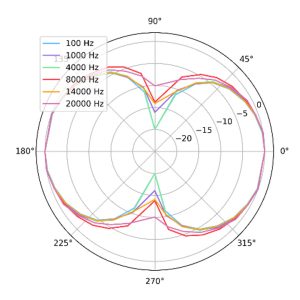
Omnidirectional Array – Delay and Sum
40mm Spacing
• +3dB SNR from spec
• 1.5dB Average DI
• Two microphones

Omnidirectional Array – Differential
10mm Spacing
• -17dB SNR from spec
• 4.6dB Average DI
• Two microphones

